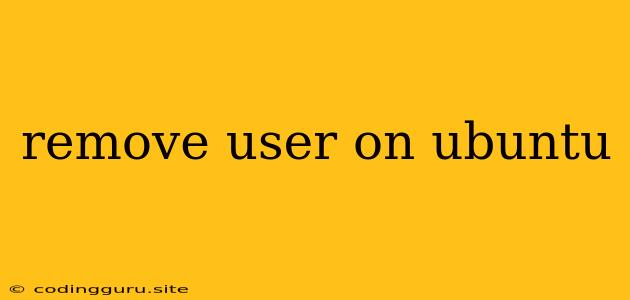Removing Users from Your Ubuntu System
Managing users on your Ubuntu system is a critical part of maintaining its security and efficiency. Sometimes, you may need to remove a user account for various reasons, such as when a user is no longer active, has left the organization, or if you've created a temporary account for testing purposes.
This guide will walk you through the process of removing users from your Ubuntu system in a safe and efficient manner.
Understanding User Removal
Before you embark on the removal process, it's essential to understand the implications. Removing a user permanently deletes their account and all associated data. This includes:
- Home Directory: The user's home directory, located in
/home/along with all its contents, will be deleted. - Files and Data: Any files and data stored in the user's home directory will be lost permanently.
- User Settings: All user settings, preferences, and configurations related to the user will be removed.
- Permissions: Any permissions the user had on files and directories will be revoked.
Steps to Remove a User
Follow these steps to safely remove a user account from your Ubuntu system:
-
Identify the Username: First, determine the exact username of the account you want to remove. You can use the command
whoamito check your current username orid -uto get the user ID. -
Log in as Root: It's crucial to perform this operation as root (super-user). You can switch to root using the
sudo -icommand. -
Verify User Existence: Before removing a user, it's always a good practice to verify if the account exists. Use the
idcommand followed by the username to check for the user's existence. For example:id username -
Remove the User: To remove the user, use the
userdelcommand followed by the username. For example:userdel username -
Delete Home Directory: The
userdelcommand usually deletes the home directory automatically. If you want to manually delete the home directory, you can use the following command:rm -rf /home/usernameCaution: Use this command with extreme care as it will permanently delete all files in the directory.
-
Remove User Group (Optional): If the user belongs to any specific groups, you might want to remove them from those groups as well. You can use the
gpasswdcommand to manage groups. For example:gpasswd -d username groupname -
Verify User Removal: After removing the user, use the
idcommand again to verify that the account is no longer present.
Example Scenario
Let's say you want to remove a user named "testuser" from your Ubuntu system. Here's how you would do it:
-
Log in as root:
sudo -i -
Verify user existence:
id testuser -
Remove the user:
userdel testuser -
Verify user removal:
id testuser
Important Considerations
- Backup: It's highly recommended to create a backup of the user's home directory before removing the account. This way, you can recover any critical files or data if needed.
- Permissions: Ensure you have the necessary permissions to remove the user. If you are not root, you might need to use
sudoto gain the required privileges. - System Files: Never attempt to delete system files or directories as this can compromise the stability of your Ubuntu system.
Conclusion
Removing users from your Ubuntu system is a straightforward process when you understand the steps involved. Always double-check the username and consider backing up important data before proceeding with the removal. Remember, removing a user permanently deletes their account and all associated data, so proceed with caution.
